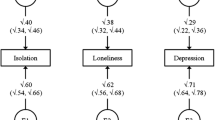Abstract
Environmental factors more common in twins than singletons appear to be disadvantageous with respect to intelligence. If these factors contribute to within-pair differences in IQ, the effect should be found more in the cotwin lower in IQ (the low twin) than in the cotwin higher in IQ (the high twin). In this case, the variance of the low twins should exceed that of the high twins. This hypothesis was tested for five samples of monozygotic (MZ) twins and three samples of dizygotic (DZ) twins but was confirmed only for the MZ samples. These results suggest that there are disadvantageous environmental factors unique to MZ twins which contribute to within-pair variability. Such factors will cause heritability coefficients obtained using MZ twins to be underestimated.
Similar content being viewed by others
References
Boklage, C. E. (1985). Interactions between opposite-sex dizygotic fetuses and the assumptions of the Weinberg Difference Method epidemiology.Am. J. Hum. Genet. 37:591–605.
Burt, C. (1966). The genetic determination of differences in intelligence: A study of monozygotic twins reared together and apart.,Br. J. Psychol. 57:137–153.
Guilford, J. P., and Fruchter, B. (1973).Fundamental Statistics in Psychology and Education, 5th ed., McGraw-Hill, New York.
Hay, D. A., and O'Brien, P. J. (1983). The role of parental attitudes in the development of temperament in twins at home, school, and in test situations.Acta Genet. Med. Gemellol. 33:191–204.
Hay, D. A., O'Brien, P. J., Johnston, C. J., and Prior, M. (1984). The high incidence of reading disability in twin boys and its implications for genetic analyses.Acta Genet. Med. Gemellol. 33:223–236.
Horn, J. M., Plomin, R., and Rosenman, R. (1976). Heritability of personality traits in adult male twins.Behav. Genet. 6:17–30.
James, W. H. (1982). The IQ advantage of the heavier twin.Br. J. Psychol. 73:513–517.
Jensen, A. R. (1969). How much can we boost IQ and scholastic achievement?Harvard Educ. Rev. 39:1–123.
Jensen, A. R. (1970). IQs of identical twins reared apart.Behav. Genet. 1:133–148.
Jensen, A. R. (1977). Cumulative deficit in IQ of blacks in the rural South.Dev. Psychol. 13:184–191.
Jinks, J. L., and Fulker, D. W. (1970). Comparison of the biometrical genetical, MAVA, and classical approaches to the analysis of human behavior.Psychol. Bull. 73:311–349.
Juel-Nielsen, N. (1965). Individual and environment: A psychiatric-psychological investigation of monozygotous twins reared apart.Acta Psychiat Neurol. Scand. Monogr. Suppl. 183.
Loehlin, J. C., and Nichols, R. C. (1976).Heredity, Environment and Personality, University of Texas Press, Austin.
Loehlin, J. C., and Vandenberg, S. G. (1968). Genetic and environmental components in the covariation of cognitive abilities: An additive model. In Vandenberg, S. G. (ed.),Methods and Goals in Human Behavior Genetics, Academic Press, New York, pp. 163–170.
Matarazzo, J. D. (1972).Wechsler's Measurement and Appraisal of Adult Intelligence, 5th ed., Williams & Wilkins, Baltimore.
Newman, H. H., Freeman, F. N., and Holzinger, K. J. (1937).Twins: A Study of Heredity and Environment University of Chicago Press, Chicago.
Price, B. (1950). Primary biases in twin studies: a review of prenatal and natal difference producing factors in monozygotic pairs.Am. J. Hum. Genet. 2:293–352.
Rosenthal, R. (1978). Combining results of independent studies.Psychol. Bull. 85:185–193.
Shields, J. (1962).Monozygotic Twins Brought Up Apart and Brought Up Together, Oxford University Press, London.
Vandenberg, S. G. (1968). The nature and nurture of intelligences. In Glass, D. C. (ed.),Genetics, The Rockefeller University Press and Russell Sage Foundation, New York.
Author information
Authors and Affiliations
Rights and permissions
About this article
Cite this article
Bailey, J.M., Horn, J.M. A source of variance in IQ unique to the lower-scoring monozygotic (MZ) cotwin. Behav Genet 16, 509–516 (1986). https://doi.org/10.1007/BF01066337
Received:
Accepted:
Issue Date:
DOI: https://doi.org/10.1007/BF01066337




